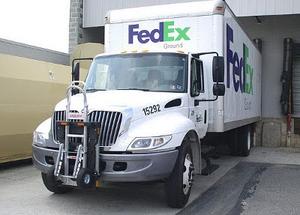Nuclear mattersFedEx loses -- then finds -- radioactive rods
The shipment of radioactive rods sent from Fargo, North Dakota, to Knoxville, Tennessee, posed little threat, but its misplacement underscores the need to track low-hazard materials that could be used in small-scale terrorist attacks, experts say; as al Qaeda has shifted its tactics from 9/11-scale attacks to smaller attacks which aim to create fear and do economic damage, there is growing concern about low-radiation materials which are widely used in research, medical facilities, and industry; such materials may not be suitable for a nuclear bomb, but could be used to create “dirty bombs,” which cause fewer casualties but can release hazardous materials when they explode

Not FedEx's usual performance // Source: picasaweb.google.com
Earlier this month, FedEx predicted it would ship more than 223 million packages over the holiday season — but the one with radioactive material seemed to be the wrong one to lose. A shipment of radioactive rods that went missing Thanksgiving Day was found Friday in Tennessee by the shipping company FedEx.
Though the materials, used for medical equipment, posed little threat to the public, the misplaced shipment underscores the need to track low-hazard materials that could be used in small-scale terrorist attacks, experts say. The Los Angeles Times quotes Sandra Munoz, a FedEx spokeswoman, to say that the rods, used to calibrate quality control in CT scans, contain little energy and a low concentration of radiation. The shipment was sent from Fargo, North Dakota, and was reported missing at its destination in Knoxville, Tennessee. FedEx alerted all of its U.S. stations about the missing shipment.
The shipment was found at a FedEx station in Knoxville, with its shipping label missing from the outer box, Munoz said. All of the rods were intact and no FedEx employees were exposed to radiation.
Three shipments of radioactive rods were mailed earlier last week. The recipient notified FedEx when only two containers arrived in Knoxville, Munoz said.
The rods were packed in a metal cylinder, known as a pig, which weighs about twenty pounds and is about ten inches long. Because the pig remained sealed, the rods did not pose a threat, Munoz said.
Though it was unlikely anyone could have used the rods to create a serious weapon, low-hazard materials are becoming more attractive to terrorists who are less interested in 9/11-scale attacks and more interested in creating fear and economic damage, according to Edwin Lyman, senior staff scientist at the Union of Concerned Scientists, a nonprofit based in Cambridge, Massachusetts.
Lyman said such materials can be used to create “dirty bombs,” which cause fewer casualties but can still release hazardous materials when they explode.
The Nuclear Regulatory Commission told Reuters that the radioactive material was not an unusual package for a company such as FedEx to ship. “We actually have a dangerous goods department that works with shippers to ensure that they have the right packaging material, labeling, and all of the things that are necessary to ship this type of material,” a spokesman said.
